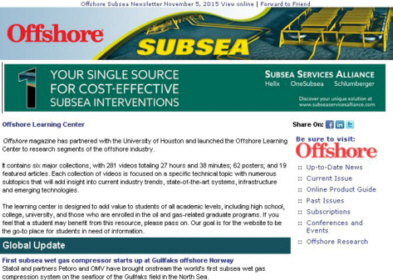|
Making the case for an all-subsea development
David Paganie, Houston
Oct. 2015 + + + Statoil and its partners are moving the
industry one step closer to an all-subsea field development solution. Last
month, following a lengthy qualification and testing period, the
industry's first subsea gas compression facility became operational in the
Norwegian Sea. It also marks a milestone in Statoil's quest to qualify and
prove all of the elements of a full-scale "Subsea Factory."
The new "dry" subsea compression system is designed to boost recovery from
the Midgard reservoir on Ăsgard from 67 to 87%, and from 59 to 84% from
the Mikkel reservoir, for an additional 306 MMboe of total output. The
solution involves the connection of two 11.5-MW centrifugal compressors
equipped to handle 21 MMcm/d to existing subsea templates and piping the
produced hydrocarbons 40 km from the Asgard B semisubmersible production
platform. Qualification of the technology began in 2005 and involved about
50 components/systems. See:
e-news-MAN-Worlds-First-Subsea-TurboCompressor.htm
Meanwhile, a separate, stand-alone project on the Gullfaks field will
employ the industry's first subsea "wet" gas compression system. It is
designed to increase recovery from the Gullfaks South Brent reservoir by
22 MMboe. The solution, involving two 5-MW wet gas compressors with
capacity to handle 10 MMcm/d, is connected to existing subsea templates.
The hydrocarbons will be transported via pipeline some 15 km from the
Gullfaks C semisubmersible production platform. Qualification of
helico-axial multiphase compressor technology for the project has been
ongoing since 2008. See:
e-news-Statoil-First-wetgas-compression.htm
In general, a well with subsea compression can produce at lower wellhead
pressures, thereby accelerating production and/or increasing recovery. The
difference relative to topside compression is an improvement in wellhead
pressure depending on water depth, by locating the compressor closer to
the wells. The subsea approach is also thought to be more energy efficient
than the traditional topside solution.
Business case
The business case for an all-subsea development is heavily influenced by
the production phase of a reservoir, explains DNV GL in a recent position
paper: "All Subsea - Creating Value from Subsea Processing."
The firm finds that, for brownfield projects, the various subsea systems
may be used alone or in combination with other technologies. In contrast,
an all-subsea solution for a greenfield project has more limited
applicability. Meanwhile, FLNG technology is emerging as the preferred
development concept for greenfield gas developments as an alternative to a
subsea tieback directly to shore. For more on the
FLNG market and topsides
weight considerations, see page 58 for a report by Nick White with
Granherne.
The DNV GL paper suggests that the Ăsgard and Gullfaks
projects, together, illustrate that the strongest candidates for
brownfield subsea compression are likely projects in mature areas such as
Northwest Europe. The infrastructure in the area is sufficient for
pipeline transport, onshore processing is developed, and power is
available from a stable grid onshore. For more on the market in Northwest
Europe, see page 32 for a report by Markus Naevestad and Jo Husebye with
Rystad Energy.
The business case for wet subsea compression on Ăsgard was strengthened by
the lack of available space on the field's platform topsides, which would
have required a new compression platform in the absence of an alternative.
For fields that are larger or have long step-out distances, such as
Gullfaks, and thus require greater pressure boost, dry gas compression
emerges as a feasible solution for the business case. The configuration
also allows for the tie-in of future satellite wells.
The successful installation and start-up of subsea compression in the
Norwegain Sea illustrates the industry's ongoing commitment to advancing
susbsea technology. However, the length of the qualification process
raises an interesting question: Is it possible to advance the pace of
technology development without compromising quality and integrity? More
research and development is needed in the areas of condition monitoring,
power transmission and distribution, and storage, to enhance the case for
an all-subsea development.
David Paganie, Chief Editor Offshore Magazine
Source: Offshore Magazine &
Subsea Offshore Newsletter, Oct. 2015
|
 Worldwide more than Worldwide more than
100,000 paid subscriptions
Since May 2015
Oil, Gas &
Petrochem (OG&PE) is published as part of the
OIL & GAS
JOURNAL to serve a consolidated monthly audience of 135,000 oil/gas professionals worldwide
»
read more |

Worldwide
more than 48,000 subscriptions -
100% one-year direct request
qualification

'What's New' in Upstream, Midstream and
Downstream Products & Services. Circulation 37,000
PennWell
Petroleum Group:
Oil & Gas Journal
Oil & Gas Journal Russia
OGJ_eNewsletter
OGJ-Website-Statistics
Oil, Gas & Petrochem Equipment
Offshore Magazine
Offshore
Russia
Offshore eNewsletter
Offshore
Website Statistics
Oil & Gas Financial Journal
+ + +
For more information, media
kits or
sample copies please contact
Andreas
Sicking
+49 (0)2903-338570
wilhelms@pennwell.com
www.sicking.de
|


